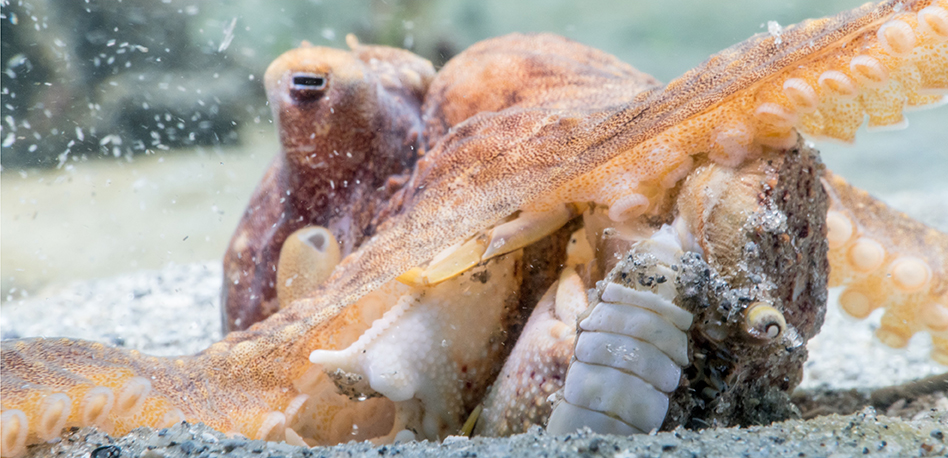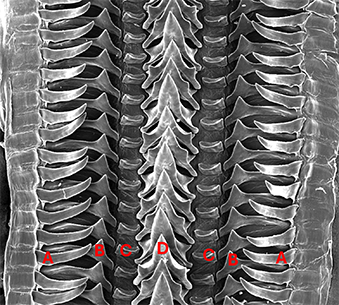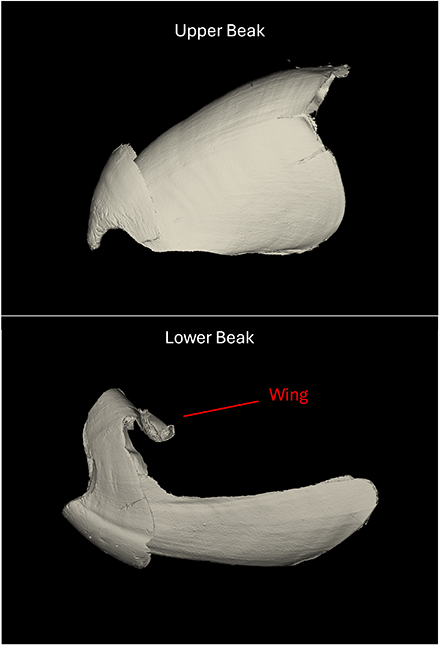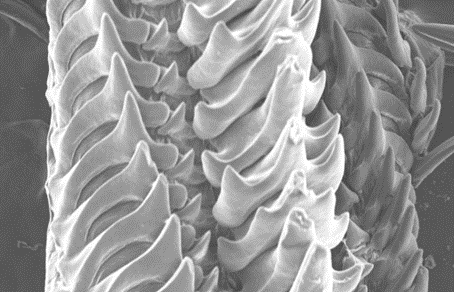
Author: Colleen Hecker
Date: August 15, 2024
Note: An earlier version of this article is under review for publication in the OctoNation Blog . It has been revised here for publication in the FAU Marine Lab Newsletter.
While the tooth fairy hasn’t made any recent visits to the FAU Marine Lab, they make plenty of visits to our study animals in the Lake Worth Lagoon — octopuses! Octopuses and their mollusc relatives like snails, slugs, squids (and more), have a small, chainsaw-like structure loaded with teeth called a radula. FAU Researchers are using differences in the shape and the number of the teeth on these tiny “chainsaws” to identify species of octopuses residing in the Lake Worth Lagoon (Riviera Beach, Florida), such as the southeast Florida common octopus and the Atlantic longarm octopus. Using this technology, we can tell seemingly identical octopus species apart – an important step towards documenting and conserving biodiversity!
Radulae, however, can be tinier than a grain of rice, so FAU Marine Lab’s scientists must use powerful scanning electron microscopy (SEM) to see these itty-bitty chainsaws in full detail. This fancy microscope sends out a beam of electrons that interacts with the surface of the object being scanned, in this case a radula. The result is a signal that contains information about the shape and composition of the sample and results in an image. FAU Marine Lab Ph.D. candidate, Jamie Knaub, trained a number of FAU researchers to use a SEM for observations on the shape of octopus teeth to be used for species identification.
Let’s join postdoctoral researcher, Dr. Chelsea Bennice, her master’s student, Colleen Hecker, and their undergraduate intern, Matthew Zoll, at the FAU High School Owls Imaging Lab as they peer under the microscope to discover more about the rad radula and other octopus feeding structures that will make your teeth chatter!

|
| From left to right, FAU Marine Lab postdoctoral research fellow Dr. Chelsea Bennice, her master’s student, Colleen Hecker, and their undergraduate intern, Matthew Zoll, gathered around the scanning electron microscope at FAU High School Owls Imaging Lab observing a squid radula. |
Putting the “Rad” in Radula
This rad name stems from the Latin radere, meaning “to scrape.” The term “radula” was first used in reference to instruments like rasps used for scraping. Octopus radulae are aptly named, as they too are powerful, scraping tools, like a rasp (or chainsaw), the radula scrapes over food, grinding it up as a form of mechanical digestion. The radula is composed of chitin. Chitin is a common source of armor across lifeforms, from the hard shells of crabs to the cell walls of fungi. Both tough and flexible, it is the ideal material for cephalopod (octopus, squid, and cuttlefish) teeth! Chitin is made up of complex sugars, meaning octopuses possess a literal “sweet tooth!”
Octopus Teeth Have Unique Names
Octopuses can have over 100 teeth in their tiny chainsaw, giving them plenty of tools to slice up their prey. Much like our own teeth have special names (think, “bicuspids” and “molars”), octopus’ teeth also have unique names, like the central rhachis, lateral, and marginal teeth (labeled in the image below). Radular morphology can be unique to an octopus species, just like dental records are unique to individual people. Counting these teeth and characterizing their morphology (by their width, length, and shape) helps Dr. Bennice and Colleen tell seemingly identical octopus species apart, an important step towards documenting and conserving biodiversity.

|
| An Atlantic longarm octopus radula photographed at 100x magnification. From the outside to inside: (A) marginal teeth, (B) and (C) lateral teeth, and (D) the central or rhachis tooth. Photo by Dr. Chelsea Bennice. |
The Chainsaw’s Sidekicks
In addition to the tiny chainsaw that is the radula, octopuses have other additional feeding structures! Another toothy structure like the radula is called the salivary papilla, which functions like a combined power drill and syringe, lying just below the radula. When an octopus eats hard-bodied prey like clams or snails with a thick shell, they will use the salivary papilla to drill a hole in its shell. They then inject venom (a cocktail of toxins and enzymes) into this hole, relaxing the prey’s muscles and loosening it up from the hard shell. The salivary papilla thus delivers the first punch; the second punch comes after the radula moves in to scrape away the prey’s tissue.
Octopuses also have a third feeding structure up their many sleeves (or should we say arms!). They have beaks that resemble those of a parrot. Like the radula, the beaks are also made of chitin. The beaks come in two parts, an upper and lower beak. These strong beaks are useful for crushing through the tough shells of prey like clams, mussels, and crabs.
Pictured below are images from a computerized axial tomography (CAT) scan of southeast Florida common octopus’ beak. You may be familiar with CAT scans as they are commonly used in medical diagnostics, but they also have powerful applications in marine biology. These CAT scans allow us to see these octopus beaks in incredible detail. See the long wing on the lower beak? The lower beak has two long wings on either side that distinguish it from the upper beak. We use the phrase, “long lower” to help us tell the upper and lower beaks apart.

|
| Upper (top) and lower (bottom) beaks of a southeast Florida common octopus imaged via CAT scan. When the beaks are closed, the upper beak sits within the lower beak, giving octopuses an underbite. Photos by Jamie Knaub, FAU Ph.D. Candidate and Owls Imaging Lab Research Technician. |
The Tooth Fairy’s Favorite Customer
Once people lose their baby teeth and their adult teeth grow in, they are stuck with that adult set of teeth for life! However, octopus teeth get replaced throughout their lifespan. Fortunately for octopuses, the chainsaw-like radula moves forward in the mouth like a conveyor belt, allowing the old teeth to be re-absorbed by the subradular organ . The subradular organ releases a substance that dissolves old, worn teeth (like the central rhachis teeth you can see in the SEM image below). As old teeth are lost, new ones keep coming in, ensuring that octopuses always have sharp teeth. As octopuses continually lose old teeth and gain new teeth, the tooth fairy makes plenty of visits underwater to our eight-armed friends.

|
| A southeast Florida common octopus’ radula taken at 150x magnification. Photo by Colleen Hecker. |
Are your teeth chattering yet? Ours certainly are! After learning all about the many aspects of octopus’ radula and teeth, check out the side-by-side comparison of the Atlantic longarm and southeast Florida common octopuses’ radulae below to see if you can spot their differences. These comparisons allow us to answer the question: who’s who in the Lake Worth Lagoon?
There is still much to learn about octopuses and their unique teeth. Scientific pursuits like those of Dr. Bennice and Colleen’s will help the FAU Marine Lab uncover many more octopus adaptations and awesome octo-facts!

|
| Atlantic longarm octopus’ radula (A) and the southeast Florida common octopus’ radula (B), taken at 150x and 75x magnification, respectively. Notice that the southeast Florida common octopus’ radula has more dramatic cusps on the central, rhachis teeth than the Atlantic longarm octopus. What other differences can you spot between the two? |
Acknowledgements: Radulae and beak images were produced using the JEOL JCM-6000 Plus Neoscope - Scanning Electron Microscope and Bruker SkyScan 1173 – Benchtop Micro CT scanner, respectively, at the Florida Atlantic University High School Owls Imaging Lab (RRID:SCR_023805). Jamie Knaub instructed Dr. Bennice and Colleen Hecker in use of the scanning electron microscope and produced the CT scanned images seen herein.